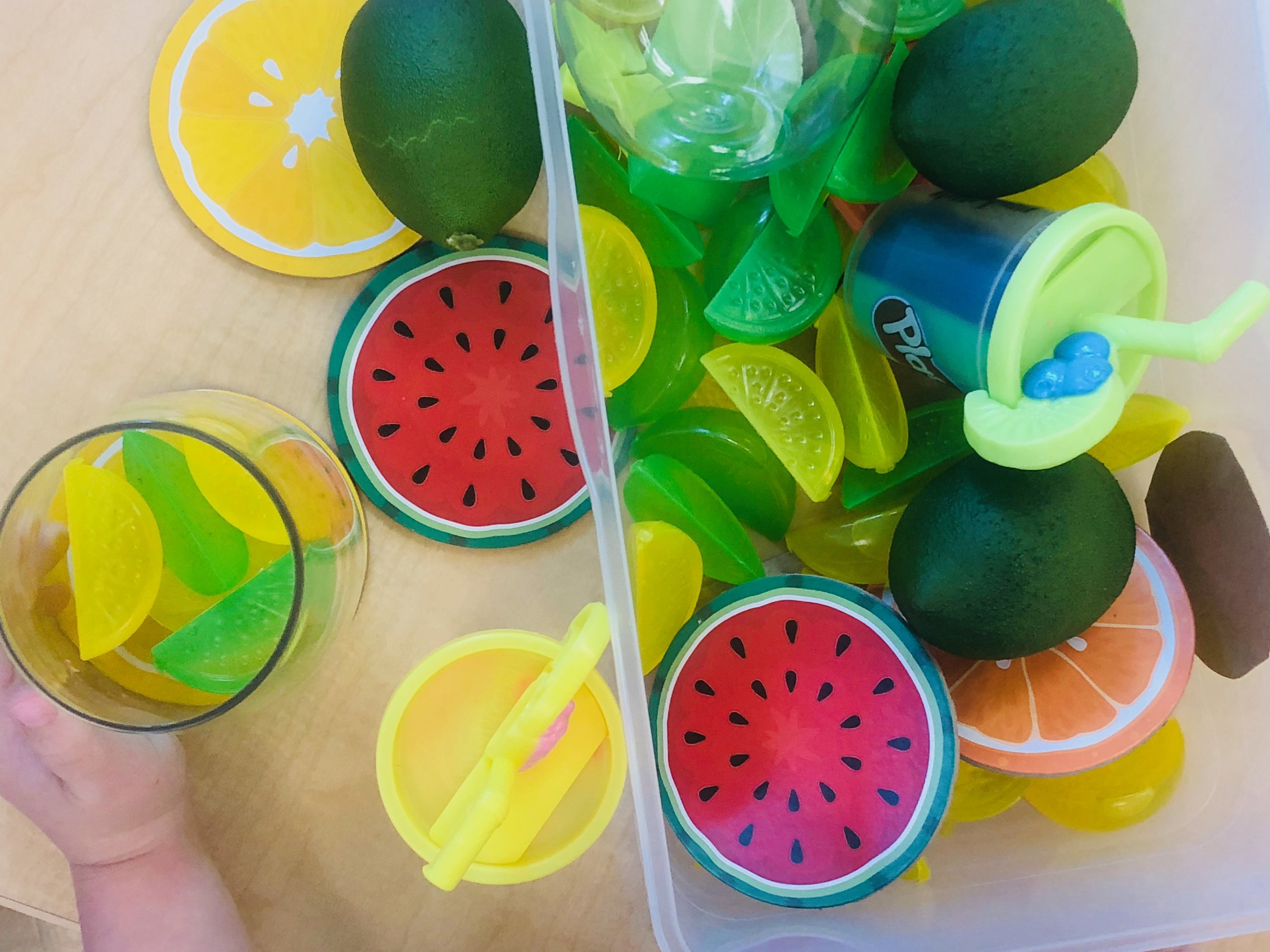Supercharging Speech Therapy with Sensory Bins: Boosting Communication Skills and Beyond
Are you ever stuck wondering how to make your therapy sessions more engaging and effective?
Lemonade Sensory Bin filled with play-do, plastic cups, spoons, limes, and lemons (plastic ice fruit shapes) and fruit coasters (all from the Dollar Store)
Get ready to supercharge your speech therapy toolkit with the power of sensory bins! In this blog post, we're diving into the incredible world of sensory bins and how they can solve the age-old problem of finding engaging, functional activities to target speech sounds, motor speech movements, phonological processing disorders, expressive and receptive language goals, social communication and play skills.
It does take initial work in the beginning adding items to the bins, but after you can pull them out year after year with no prep.
WHAT IS A SENSORY BIN?
It is a container filled with a variety of fillers like beads, sand, water, rocks, dried pasta, dried corn. Within these bins you can add small toys, spoons, cups, little people, storybook props, tongs, and scoopers. You can fill your sensory bin according to themes like dinosaurs or sharks. I like to use plastic containers with lids so I can store my bins year after year.
Gardening Sensory Bin filled with green dyed pasta for grass, plastic flowers, flower pots and carrots, scoopers and herb markers.
WHAT ARE THE BENEFITS OF SENSORY BINS?
Enhanced Sensory Stimulation: Children with sensory processing deficits often struggle with communication due to sensory challenges. Sensory bins provide the extra stimulation needed to activate their senses, kickstarting the brain and central nervous system for optimal communication development.
Memory Activation: Our senses are memory superheroes! When we engage multiple senses during therapy, we unlock more opportunities for memory activation and retention. Sensory bins create memorable experiences that help children recall and apply speech and language skills long after the session ends.
Joint Attention and Social Interaction: Building connections goes hand in hand with building relationships. Sensory bins foster joint attention, turn-taking, and social interaction as children explore and play together. They're not just mastering language, but also honing crucial social communication skills during play.
Building Brain Connections: Research confirms that sensory play, including sensory bins, builds strong connections in the brain's pathways. These connections enable children to tackle complex learning tasks, opening the door to remarkable progress in speech and language development.
Descriptive Vocabulary Expansion: Step into the sensory bin wonderland, and watch descriptive vocabulary flourish! As children immerse themselves in the sensory experience, they explore colors, shapes, textures, and sizes, expanding their expressive language skills and painting vivid pictures with their words.
WHAT GOALS CAN I TARGET?
Articulation and Apraxia: Say goodbye to dull articulation drills! With sensory bins, we can transform speech practice into a thrilling treasure hunt. Imagine burying small objects or pictures with target sounds and having your little ones search for them while practicing their speech. Use a child’s one, two or three target words over and over forming those motor neural brain pathways for tons of trials for kids with apraxia. It's interactive, engaging, and super effective in improving speech intelligibility and motor planning.
Phonological Processing Disorders: Sensory bins provide a multisensory approach that works wonders for children with phonological processing disorders. Sorting objects based on initial sounds or creating new words by manipulating objects with target phonemes takes learning to a whole new level. The tactile experiences and hands-on exploration boost sound discrimination and syllable awareness, helping children conquer phonological challenges.
Expressive and Receptive Language Goals: Sensory bins are a goldmine for expressive and receptive language development. Whether it's using prepositions, expanding sentences, or describing objects with vivid descriptors, sensory bins provide the perfect backdrop for language growth. The best part? Joint attention and social interaction come naturally as children engage their senses, fostering communication skills while having a blast.
HOW CAN I USE THEM?:
Have the child find small objects or pictures that contain their target speech sounds and use them in sentences or short stories.
Encourage the child to bury small objects in the sensory bin and practice saying target words or sentences while retrieving them.
Use objects with different textures, shapes, or sizes in the sensory bin and ask the child to imitate specific motor movements, such as sliding, twisting, or pushing, while describing their actions aloud.
Introduce objects with different initial or final sounds and ask the child to sort them into corresponding containers.
Use objects with target phonemes and have the child manipulate and combine them to create new words or syllables.
Incorporate prepositions by placing objects in different locations within the sensory bin and asking the child to describe their position (i.e.., "The lemon is under the cup").
Use action verbs related to the sensory bin materials and encourage the child to act them out or create sentences using the verbs (e.g., "The dinosaur is roaring," "I am pouring sand into the bucket").
Expand sentence length and complexity by encouraging the child to describe the objects using descriptors (e.g., colors, sizes, textures) or by combining multiple sentences into a cohesive narrative.
Use them with paired books and props and have children retell the story with the props in the sensory bin.
Sensory bins provide a versatile and engaging platform for targeting a wide range of speech and language goals in children. By harnessing the power of tactile experiences, therapists, teachers and parents can create a multisensory environment that promotes articulation, motor speech movements, phonological processing skills, as well as expressive and receptive language development.
The possibilities are endless when it comes to sensory bins. Let your creativity shine, and watch your therapy sessions transform into captivating adventures that leave a lasting


